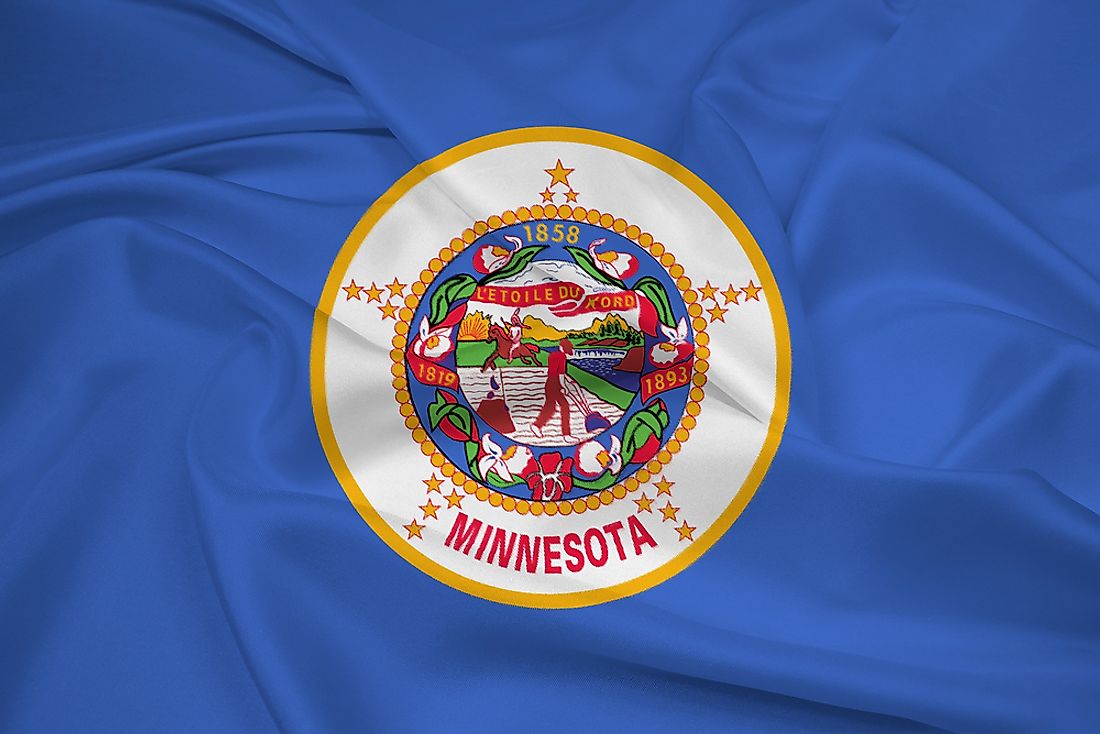Minnesota State Flag

The Minnesota flag was designed 1893. It is a predominantly blue flag with the seal of the state positioned in the middle. The design of the flag was reviewed in 1957 to make it easy to manufacture by simplifying the features in the seal. In the same year, it was adopted officially though minor modification was done in 1983 after alterations were done on the seal.
Design and Features of the Flag
The official flag of the state of Minnesota is rectangular in the ratio of 7:3. The design is in a field of blue with the image of the seal in the middle. The seal is surrounded by a white banner forming an outer circle with 19 stars distributed all-round the circle. These stars symbolize the states of the US with Minnesota being the nineteenth state to join the union. On the upper part is the largest star which denotes the North Star and the state of Minnesota. The stars are symbols of being outstanding states.
The images on the seal are a man plowing and an indigenous American Indian on horseback holding an axe and a gun. Images symbolize the rich agricultural potential, the landscape, and the heritage of the early inhabitants. On the background of the seal is a river depicting the importance of Rivers Mississippi and St Anthony to the state. The state tree is captured by the three pine trees on the background. The trees symbolize the timber-rich regions of St. Croix and Lake Superior. The seal is surrounded by the pink lady flower which is the official state flower.
There are three years captured within the state flower, which are 1858, 1819 and 1893. The year 1819 is captured therein in remembrance of the first dwelling place constructed between 1820 and 1824. The year 1858 represents the year Minnesota State joined the US. Lastly, 1893 commemorates the year when the national flag was adopted. The red ribbon in the seal with the words “star of the North” denotes the state motto meaning that when the state joined the union it was the one on the furthest Northern side.
There are various colors in the flag. The blue color is a symbol of surveillance, persistence, and justice. The red color denotes the ability to endure and bravery of the people while color white symbolizes peace.
History of the Minnesota Flag
Between 1861 and 1865, during the Civil War, Minnesota battalions carried a different flag which was basically blue displaying the seal in the middle of the American eagle. In 1893, the Women’s Auxiliary Board held a competition to design a state flag. The flag was to be displayed in the Chicago World exhibition. The best designer was to be awarded fifteen dollars. Over 200 entries were received, and Amelia Hyde Center's design declared the winner. The initial flag was made of silk by Pauline Fjelde and Thomane Fjelde.
Amendments were made in 1957 in preparation for the State Centennial celebrations. Royal blue color was adopted at the sides and the colors of flowers used in the seal were redesigned.
Uses of the Minnesota State Flag
The flag should be flown during all official functions and on all state buildings. Once it is lowered, it should be folded lengthwise in a way that the motto “star of the North” is displayed in the triangle. Nevertheless, in 2001, the design of the flag was ranked lowly by the North American Vexillological Association for being very complex.











